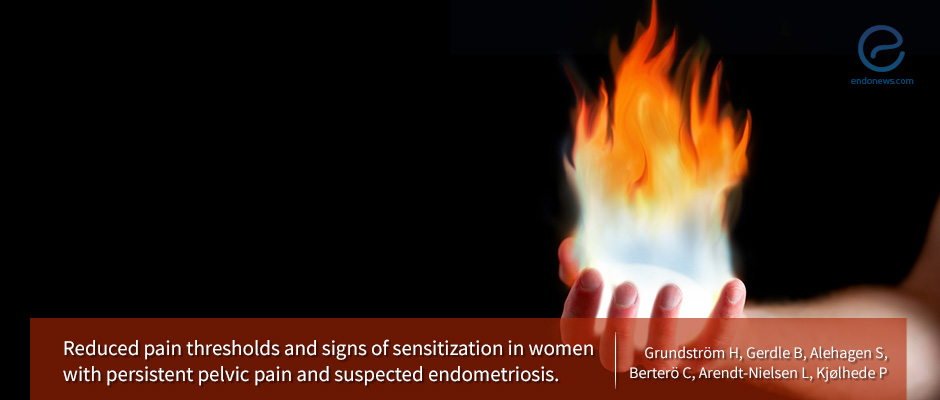Women with Persistent Pelvic Pain Have a Lower Pain Threshold
Feb 14, 2019
This is the case whether or not they have endometriosis.
Key Points
Highlights:
- Women with persistent pelvic pain have a significantly lower pain threshold compared to women without persistent pelvic pain.
- The longer the persistent pelvic pain the lower the pain threshold.
- This could be due to central sensitization where the nervous system is in a persistent state of high reactivity.
Importance:
- Women with endometriosis often experience persistent pelvic pain.
- It is therefore important that they are treated more thoroughly before they reach a state of central sensitization and feel even more pain.
What's done here:
- Researchers assessed the pain threshold for heat, cold, and pressure of 37 women with persistent pelvic pain.
- The pelvic pain was caused by endometriosis in 13 women, and there were 55 healthy controls.
- Researchers also assessed the women’s quality of life and any symptoms of anxiety and depression.
Key results:
- Women with persistent pelvic pain have significantly lower pain thresholds compared to women without pelvic pain.
- There is no difference in pain threshold between women with and without endometriosis experiencing persistent pelvic pain.
- The duration of pelvic pain positively correlated with reduced pain thresholds.
- In women with persistent pelvic pain, pain thresholds for heat correlate significantly with the dimension of bodily pain and thresholds for cold correlated with the symptoms of depression.
Limitations:
- The study is not able to differentiate whether a reduced pain threshold was a consequence of persistent pelvic pain or a cause for it.
- Women who took part in the study might not be accurately remembering the duration of their persistent pelvic pain.
- Only one point on the body outside the area related to pelvic pain was selected to assess generalized central sensitization.
- The pain tests were conducted by four different examiners, who might have informed the participants differently about the test or performed the pressure tests differently.
- The examiners knew which women had persistent pelvic pain and which ones did not, so there could have been expectation bias, which could influence the results.
Lay Summary
Women with persistent pelvic pain, whether this is caused by endometriosis or other reason, have a significantly reduced pain threshold compared to women without persistent pelvic pain. This is according to a study by researchers in Sweden, which was published in the journal Acta Obstetricia et Gynecologica Scandinavica.
The authors suggest that this reduced pain threshold could be the result of so-called central sensitization where the nervous system goes through a process called “wind-up” and is in a persistent state of high reactivity.
“Women with pelvic pain and suspicion of endometriosis should probably be treated more thoroughly in order to prevent or at least minimize the concomitant development of central sensitization”, the researchers concluded.
In order to evaluate the pain threshold of women with persistent pelvic pain with or without endometriosis compared to women without persistent pelvic pain, the team tested the pain thresholds of the participants for heat, cold, and pressure. They also assessed their quality of life and any symptoms of anxiety and depression.
A total of 37 women with persistent pelvic pain who were suspected of having endometriosis and were admitted for laparoscopy as well as 55 control women without pelvic pain took part in the study. Later, it turned out that 13 of the 37 women who had laparoscopy had endometriosis while 24 did not.
The results showed that women with persistent pelvic pain had significantly lower pain thresholds compared to women without pelvic pain. There was no difference in pain threshold among women with persistent pelvic pain according to whether or not they had endometriosis.
The results also showed that the duration of pelvic pain positively correlated with reduced pain thresholds. In other words, the longer a woman had persistent pelvic pain, the lower was her pain threshold.
The researchers concluded that women with persistent pelvic pain may have central sensitization regardless of the presence of endometriosis. However, they said, the duration of the pain state might be a driving force in the development of sensitization.
Research Source: https://www.ncbi.nlm.nih.gov/pubmed/?term=30472739
pain threshold central sensitization perception of pain persistent pelvic pain

